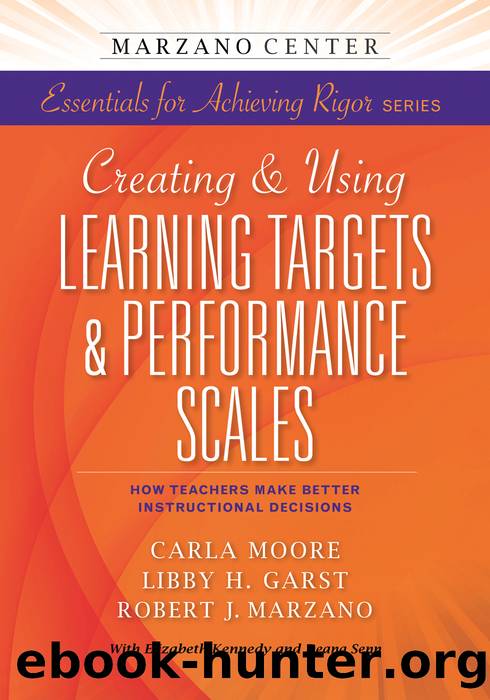Creating & Using Learning Targets & Performance Scales by Carla Moore

Author:Carla Moore
Language: eng
Format: epub
Publisher: Learning Sciences International
Published: 2016-07-14T16:00:00+00:00
Instructional Technique 2
USING TEACHER-CREATED TARGETS AND SCALES
To this point, you have learned how to create learning targets and performance scales in Part I and acquired various classroom routines in Instructional Technique 1 to jump-start your implementation of targets and scales. This second technique, using the learning targets and performance scales you have created, will help you put together the various routines into a seamless whole to create the big picture. You can view any performance scale you create, whether a simple student-friendly scale showing the progression of learning in a kindergarten English language arts unit, as illustrated earlier in Part I (see Figure X, page 39), or a complex teacher-created scale for a high school biology unit, as shown in an upcoming example in this technique (Figure 2.3).
Some teachers think of a performance scale as a frequently consulted road map leading them and their students on a journey that culminates in the attainment of a challenging academic standard. Other teachers think of scales as living classroom documents that are continually being used and adapted, such as when a teacher discovers the need to add additional targets or subtargets to further support learning one of the targets on the scale. Still others view scales as a daily organizer that provides a framework and structure on which to keep teachers and their students constantly focused as learning is progressing. All of these metaphors incorporate the essence of targets and scales: the identification of what students need to know and be able to do to attain the standard organized into a clear progression of learning targets. Whatever your preferred metaphor, make sure that you remain focused on the learning goal targets with consistency and intensity.
How to Effectively Implement Learning Targets and Performance Scales
The effective implementation of learning targets and performance scales assumes that you are becoming increasingly skilled at creating targets and scales that are consistent with the needs of your students and the cognitive complexity of specific standards. You will be unable to effectively implement this technique if the scales you create are not rigorous and faithful to the intent of the standard. The implementation of targets and scales demands that you engage in the following key teacher behaviors: 1) introduce and explain the scale and its targets to students, 2) help students become familiar with the scale, 3) refer constantly and seamlessly to the targets and scale throughout the lesson, and 4) relate activities and assignments to the targets and scale throughout the lesson.
Introduce and Explain the Scale and Its Targets to Students
Now that you have created the targets and organized the progression of learning embedded in the performance scale, consider how you will introduce and explain the scale and its targets to your unique group of students. This aspect of implementation is paramount to the success of the instructional strategy as a whole.
During the first-time introduction of a scale and its targets to your students, explain the purpose of a scale and its targets. Review the various routines introduced in Instructional Technique 1 and select only one of them to implement.
Download
This site does not store any files on its server. We only index and link to content provided by other sites. Please contact the content providers to delete copyright contents if any and email us, we'll remove relevant links or contents immediately.
| Administration | Assessment |
| Educational Psychology | Experimental Methods |
| History | Language Experience Approach |
| Philosophy & Social Aspects | Reform & Policy |
| Research |
The Art of Coaching Workbook by Elena Aguilar(48067)
Trainspotting by Irvine Welsh(20056)
Twilight of the Idols With the Antichrist and Ecce Homo by Friedrich Nietzsche(17707)
Fangirl by Rainbow Rowell(7834)
Periodization Training for Sports by Tudor Bompa(7329)
Change Your Questions, Change Your Life by Marilee Adams(6641)
This Is How You Lose Her by Junot Diaz(5774)
Grit by Angela Duckworth(4738)
Red Sparrow by Jason Matthews(4668)
Asking the Right Questions: A Guide to Critical Thinking by M. Neil Browne & Stuart M. Keeley(4576)
Paper Towns by Green John(4169)
Room 212 by Kate Stewart(4107)
Ken Follett - World without end by Ken Follett(3973)
The Sports Rules Book by Human Kinetics(3588)
Housekeeping by Marilynne Robinson(3402)
The Motorcycle Diaries by Ernesto Che Guevara(3333)
Introduction to Kinesiology by Shirl J. Hoffman(3301)
Exercise Technique Manual for Resistance Training by National Strength & Conditioning Association(3292)
Double Down (Diary of a Wimpy Kid Book 11) by Jeff Kinney(3274)
